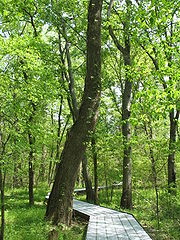
Bottomland hardwood forest
Encyclopedia

Deciduous
Deciduous means "falling off at maturity" or "tending to fall off", and is typically used in reference to trees or shrubs that lose their leaves seasonally, and to the shedding of other plant structures such as petals after flowering or fruit when ripe...
hardwood forest found in broad lowland
Upland and lowland (freshwater ecology)
In studies of the ecology of freshwater rivers, habitats are classified as upland and lowland.-Definitions:Upland habitats are cold, clear, rocky, fast flowing rivers in mountainous areas; lowland habitats are warm, slow flowing rivers found in relatively flat lowland areas, with water that is...
floodplains along large rivers and lakes. They are occasionally flooded, which builds up the alluvial soils required for the Gum
Nyssa
Nyssa may refer to:* the genus name for the tupelo tree* Nyssa , a female name** Nyssa , a companion of the Fourth and Fifth Doctors in the long-running British science fiction series Doctor Who...
, Oak and Bald Cypress
Taxodium distichum
Taxodium distichum is a species of conifer native to the southeastern United States.-Characteristics:...
trees that typically grow in this type of biome
Biome
Biomes are climatically and geographically defined as similar climatic conditions on the Earth, such as communities of plants, animals, and soil organisms, and are often referred to as ecosystems. Some parts of the earth have more or less the same kind of abiotic and biotic factors spread over a...
. The trees often develop signs of wetland trees, including knees
Cypress knee
In the biology of trees, a cypress knee is a distinctive structure in a root of a cypress tree of any of various species of the subfamily Taxodioideae. Their function is unknown, but they are generally seen in swamps...
, but can not survive continuous flooding. Typical examples of this forest type are found throughout Gulf coast states, and along the Mississippi river
Mississippi River
The Mississippi River is the largest river system in North America. Flowing entirely in the United States, this river rises in western Minnesota and meanders slowly southwards for to the Mississippi River Delta at the Gulf of Mexico. With its many tributaries, the Mississippi's watershed drains...
in the United States. It is estimated there were 24000000 acres (9,712,464 ha) in the region before foresting and farming reduced it to approximately 4000000 acres (1,618,744 ha) today.

